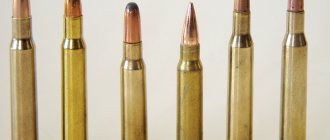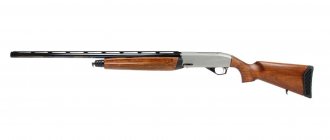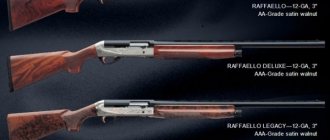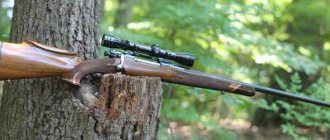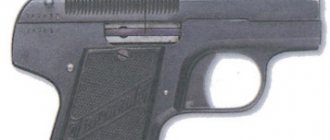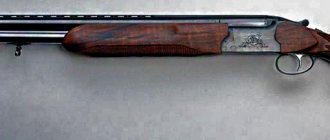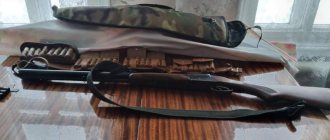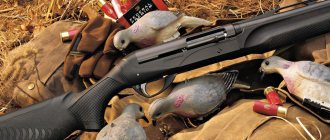| OJSC "Tula Arms Plant" | |
| Title (original): | OJSC "Tula Arms Plant" |
| Title (Russian): | TOZ |
| Story | |
| year of creation: | 1712 |
| a country: | Russia |
| city: | Tula |
| Faces of the company | |
| Other: | Tokarev Fedor Vasilievich |
| Miscellaneous | |
| of. website: | www.tulatoz.ru |
History of creation and features of the TOZ-34 gun
In the early 60s of the twentieth century, the designer of the Tula Arms Plant Nikolai Ivanovich Korovyakov began developing a lightweight and convenient gun, simple in design and maintenance. And I must say, he succeeded - in 1964, a new model TOZ-34 entered the market.
The main features of the gun can be called a simple hammerless design, created by a talented person, but without the appropriate technical education, as well as a unique design with a lower barrel arrangement, which lowers the aiming line. And at the same time, the TOZ-34 hunting rifle has high shot accuracy, “forgiving” mistakes even for beginners - for this, the gun’s design “absolved sins” associated with the shortcomings of mass production.
TKB-059: one barrel is good, but three is better!
German Korobov is a brilliant Tula gunsmith who was ahead of his time in his developments. Not a single one of his machine guns was adopted for service, and today Korobov’s name is known to a narrow circle of specialists. But everything could have turned out differently, because the designer was developing an alternative to the Kalashnikov assault rifle. His weapons were distinguished by an abundance of plastic, which was not common in the 1960s, but is actively used today. In addition, Korobov created machine guns according to the original “bullpup” design, when the firing mechanism and magazine are located at the rear of the weapon.
Experimental assault rifle TKB-059. Photo: kalashnikov.media
It is according to this scheme that Korobov’s most unusual project was made - the TKB-059 three-barreled salvo machine gun. The device could be mistaken for a gunsmith's whim, but nevertheless it had real prospects. Korobov’s main task was to achieve an ultra-fast burst, in which the recoil from the shots does not have time to deflect the barrel and allows for high accuracy of fire. Three barrels gave a fantastic rate of fire of 1400-1800 rounds per minute. Many components and parts of TKB-059 were unified with Kalashnikov assault rifles.
Korobov’s “Three-Headed Dragon” successfully passed state tests, showing very high accuracy. However, the originality of the design and the complexity of equipping the stores led to the abandonment of mass production. In addition, at that time the urgency of replacing the AK-47 was not so high.
General description of the TOZ-34 12 gauge shotgun
Structurally, the “thirty-four” is a double-barreled shotgun with a vertical barrel arrangement, hammerless type, with the now traditionally different diameters of the barrels - the upper one is shaped like a choke (smooth conical narrowing of the barrel), and the lower one is shaped like a choke (also a conical barrel, but with a reduced narrowing). This barrel bore structure ensures shot accuracy comparable to that of more expensive imported shotguns from Bernardelli, Beretta or Browning.
Both hidden hammers are cocked at the moment of “breaking” the gun for reloading, which has a positive effect on the rate of fire - an experienced shooter will only need about ten seconds to reload the TOZ-34, along with the extraction of cartridges. In the “breaking” scheme of the gun, the designer, soon after the start of mass production, abandoned the outdated scheme with squeezing the trigger, replacing it with a lock with a flag lock - this saved the TOZ-34 from the problem of sudden breaking of the gun, which every owner of a double-barreled gun has encountered at least once in his life guns.
Each barrel has its own trigger, which allows you to select the cartridge required for the shot (there are “exotic” shooters who prefer to load the gun with two types of cartridges). There is one common safety for both triggers, located behind the barrel break lever. The barrel itself has different thicknesses - the thickest part is located in the breech (the area with the highest pressure), then thins to approximately the middle of the barrel, and then towards the muzzle, thickens again - this is done to reduce the vibration of the barrel when fired.
The handle and butt of double-barreled shotguns are traditionally made of solid wood, usually birch or beech, but in piece models they also use solid walnut.
The forend is made of the same material as the butt with the handle, and is rigidly attached to the barrels and cannot be removed without a special tool.
Miniature weapons: small and bold
The legendary Lefty, who shoed the flea, had a real prototype - master gunsmith Alexey Surnin, who lived in Tula at the turn of the 18th-19th centuries. The tradition of creating miniature copies of weapons is also long-standing. Back in 1845, Tula craftsmen presented miniature pistols and a saber to the future Emperor Alexander II. Later, the creation of small copies of weapons became an excellent test for professional suitability for students of the Tula Weapons School. It opened in 1869 at the plant and continuously provided TOZ with young personnel.
Photo: Tula State Weapon Museum
And today the tradition of creating miniature weapons continues. Tula gunsmiths don't make toys - their mini-weapons always shoot. And although the design of the mechanism may differ from the original, the functionality remains the same. True, burst fire has not yet been achieved, so even copies of machine guns can only fire single shots.
The Tula Armory Museum, among other mini-weapons, houses two miniature pistols created by factory school students in the 90s of the 19th century. These are six-shot hairpin revolvers of the Lefoshe system with a caliber of 1 millimeter. These pistols are the size of a matchbox. A miniature revolver bullet can pierce a paper target in 5 steps. These pistols are fairly accurate copies of the statutory weapons of those years, made on a scale of 1 to 6. The handle of one of them is made of horn, the other of white mother-of-pearl. The accuracy and elegance of the weapon speak of the high skill of young Tula gunsmiths of the 19th century.
Serial and piece models TOZ-34
As is already clear from the classification, serial models, such as TOZ-34, TOZ-34e, TOZ-34R and EP, were produced in large quantities, in contrast to models produced in limited editions. Mass models suffered from poor quality workmanship, poor workmanship - poorly processed component joints and required significant adjustments to the mechanisms.
Combination shotguns, produced in limited quantities, namely models with the index 5.6/20 or 5.6/28, were produced with combined barrels - the upper one was rifled and had a caliber of 5.6 mm, while the lower barrel had no rifling, and was intended for firing shotgun cartridges of 20 or 28 mm caliber. Although such guns were produced in small batches, they were purely for commercial hunting, and had virtually no flaws during assembly.
Piece models were distinguished by the highest quality assembly, as well as finishing of the external parts of the gun - for example, TOZ-34-55 “Bison”. This version of the gun was equipped with a smooth 12-gauge barrel connected to a rifled barrel chambered for 9x53 mm and had a complete mount for hunting scopes PO4x34 (4x magnification) or TO6-PM with 6x magnification.
What do hunters think about weapons?
Judging by numerous reviews, TOZ-119 is more convenient to use. This is due to the fact that an external trigger was introduced into the design. The fact is that the hunter does not need to open the gun to see if it is cocked. Thanks to such a trigger, the TOZ-119 16-gauge single-barreled gun and subsequent modifications have become much safer to use. In case of misfire, the hammer is cocked again. Thus, for it to come into contact with the cartridge primer, the weapon does not need to be opened. When the trigger is pulled, the sights are closed, which signals to the hunter that the gun is not ready to fire.
Another advantage of the weapon is that the receiver is quite long. This allows the shooter to additionally equip the rifle unit with an American-made Lyman adjustable and folding ring sight. It is installed behind the external trigger. The presence of such a sight will not only have a positive effect on the accuracy of the battle. According to experts, with a sight of this type, a hunter can shoot ahead at a moving target. Many hunters also like this weapon because it weighs relatively little compared to a double-barreled weapon.
According to some owners, the locking mechanism can sometimes jam. However, as experts say, the reason for this is not a manufacturing defect, but improper operation. For example, if you do everything according to the instructions, namely, press the unlocking lever, then close the weapon, and slowly release the lever itself, then there will be no problems with locking. If, on the contrary, the gun barrel is slammed vigorously, the locking mechanism, designed for a force of no more than 10 kg, may break.
There are also complaints regarding the quality of the front sight. According to the owners, the manufacturer turned it quite roughly and not symmetrically. Other owners of these hunting rifles claim that the quality of the front sight is acceptable, since during aiming these shortcomings are almost unnoticeable. In addition, the height of the front sights may vary markedly in different guns.
Another disadvantage of this shooting unit is that it is more convenient to aim if the hammer is cocked. The opposite situation occurs when it is deflated. In this case, the hammer spoke will cover the rear sight slot. The fact is that the spokes are not made along the axis. However, this can be attributed to the fact that the guns were presented in the first experimental batch.
This model is light, maneuverable, very practical and easy to operate. These single-barreled shotguns are ideal for outdoor hunting.
Gun design
The design of the gun is surprisingly simple and understandable even to an inexperienced user - the barrels recline when the barrel holding flag is moved to the right, at the same time the firing pins are retracted inward and the barrel tips forward without the risk of damaging the mechanism. In models with a spring ejector, spent cartridges are almost completely pulled out of the breech; in other models, they must be removed manually. Cocking occurs during the “break” of the gun, when the breech of the weapon is maximally open.
Trunks
The barrel block is assembled from two conical barrels with internal chrome plating, located vertically relative to the general plane of the gun. Depending on the model, the combination of barrels can be of two types - two barrels for shot shooting with a difference in the narrowing of the barrel bores (choke-poluchok) or a combination of rifled and smooth barrels, when the smooth barrel is usually 20 or 28 caliber and is intended for more small animal or bird.
Experienced hunters most often use 20 gauge for small fur-bearing animals. With 28 caliber they go at the bird, knocking it down on the rise. But it is important to remember that it is recommended to work with 20, as well as with 28, only after the owner “gets his hands on” the TOZ-34 12 gauge.
Locking system
The TOZ-34 is equipped with a time-tested barrel locking system - the latch acts as a kind of safety device, preventing the gun from being fired until the barrels are completely locked. This maintains safety for the shooter and others, and also maintains the structural integrity of the gun. To open the chambers for their equipment, it is necessary to move the locking lever to the right and slightly shaking the barrel, pull it down towards the ground. After this, you will need to load the cartridges and move the barrels upward to return them to their original position. Upon returning the weapon to its original position, the locking lever also returns to its original position along the aiming axis, thereby releasing the firing pins.
Trigger mechanism
The trigger of the TOZ-34 hunting rifle has a device familiar to double-barreled shotguns - two hidden triggers are controlled by two triggers. The strikers are made according to a pistol-trigger design, where the trigger hits a fixed spring-loaded striker. Also, the strikers themselves are equipped with an intercepting mechanism - they intercept the release of the hammers, eliminating accidental firing from the gun and ensuring the ability to smoothly release the hammers from cocking.
At the time of development of the TOZ-34, the designer was faced with the question of what mainsprings to use - plate, twisted, or complex shaped. The choice fell on a mainspring with a complex horseshoe shape, and the decisive factor for this was the user’s ability to independently create springs from any available wire, or to purchase them at the nearest store.
It is believed that such springs in most cases quickly “wear out” the trigger mechanism box, but in fact the TOZ-34 and its modifications can withstand tens of thousands of shots without serious maintenance.
The main purpose of such springs was the ability to cope with even the hardest primers of hunting cartridges - it’s no secret that handicraft cartridges or poor quality ammunition suffer from poorly installed primers, requiring a more serious spring to pin them.
For safety, the TOZ-34 design provides for the installation of a mechanical fuse located on the right side of the gun. In the raised position it does not block the sear and allows you to shoot, in the lowered position it blocks. For convenience, the gun is equipped with mechanical cocking indicators.
Butt
Traditionally, the stock is made of a single solid material and is connected to the handle and stock of the gun. It is made from birch or beech in serial and small-scale models; piece samples have this part made of solid walnut. Often the butt plate is equipped with a rubber or plastic pad, and a cheek pad can also be installed for ease of aiming.
Despite the considerable time of production of this model, only one problem could not be solved - with too intense shooting, you can get a crack in the stock (tens, or even hundreds of thousands of shots). This problem is due to the way the trigger mechanism is attached to the stock - it is secured with a steel bolt screwed through a wooden part. It is this bolt that, when fired, puts a load on the tree and this can cause a crack in the stock over time.
However, there is no need to be afraid of this - the stock is not that expensive and fails not so often. The only drawback is that the stock is changed entirely, with the butt and handle, and often requires customization.
Operating principle
The original design determines an unusual order of interaction between parts when opening and closing the barrel. However, it is precisely these features that make the TOZ-34 a fail-safe option.
- Open the barrel by moving the locking lever to the right until it stops. In this case, the lever removes the locking frame from the groove, and the latter presses the triggers. The triggers release the strikers and they are pressed behind the plate under the action of springs.
- The bevels of the barrels press on the cocking lever, which cocks the hammer and releases the stop. It lowers under the action of a spring and fixes the locking frame
- The barrels do not rotate when opened, since the cocking lever rests against the box.
- The cocked hammers, in turn, press the pointers up. The cocking indicators protrude above the plane of the box, which is a signal about cocking.
- The upper bevel of the box presses on the ejector, which extends along with the cartridges and ejects them.
- When opened, the triggers remain cocked. This movement turns the cocking lever, raising the stop. The locking frame is released, moves forward and locks the barrels. The lever returns to its original position.
- If the locking lever does not reach the place, it must be brought in by hand.
- To shoot, move the safety to the “fire” position, aim and press the trigger. In this case, the sear is disengaged from the cocking mechanism, and the trigger, pushed out by the spring, strikes the firing pin.
The rifle must be stored unloaded with the triggers pulled. Ammunition is stored separately.
We will describe below what kind of disassembly the TOZ-34 hunting rifle requires.
Double-barreled smoothbore shotgun TOZ-34E
Tactical and technical characteristics of TOZ-34 (TTX)
| Characteristics | Indicators |
| Caliber, mm | 12x70 |
| Ammo | Buckshot, shot, cast bullet |
| Weapon length, mm | 1100 |
| Barrel length, mm | 660 |
| Chamber | 2x70 mm |
| Barrel life, shots | 10 – 12 thousand |
| Gun weight, kg | 3,3 |
| Narrowing of trunks | Upper – chok, lower – pay |
Pros and cons of TOZ-34
Like any weapon, TOZ-34 has both its positive and negative sides.
Advantages
"Vertical" guns are more convenient for a quick repeat shot - both barrels are on the same line of sight
Light weight, which is useful when shooting offhand - for example, at a bird on the rise
Internal hammers reduce the time it takes to reload a weapon - when the barrel is returned to its place, the hammers are already cocked
Accuracy and balance of the gun, which will be a good indicator for inexperienced shooters
Possibility of choosing a barrel (in case of loading with different cartridges)
Flaws
TOZ-34 does not tolerate frequent use of powerful ammunition - the barrel locking mechanism is not very reliable, and the hinge mechanism can also fail due to them
High accuracy can also be attributed to disadvantages - for example, it is difficult to hit several targets in a flock with shot
Far from acceptable pellet shedding at firing distances reduces the chances of successfully hitting the target when fire is fired at distances over thirty meters
A fatal drawback is the idle pull of the triggers, which increases the firing time
As you noticed, the gun has more advantages than disadvantages. Moreover, I did not list the minor amenities and inconveniences of the gun.
Advantages
The TOZ-34 shotgun has many advantages, thanks to which it has become so popular among our hunters:
- Excellent accuracy of the gun. High accuracy is achieved by using strong chokes and drilling the barrel bore to 18.5-18.7 mm. A smoother transition from the chamber to the bore reduces the pressure in the first phase of the shot and reduces the deformation of the shot, hence improving the parameters of the shot. Sometimes there are guns whose choke constrictions are stronger than those indicated in the passport; it is better for the owner of the gun to measure the choke constrictions themselves with a caliper in order to accurately verify the size of the chokes of his gun.
- Light weight. The standard TOZ-34 weighs 3.1-3.2 kg, but in the piece version the weight of the gun was reduced to 3.0 kg. The main competitor of the IZH-27, according to its passport, weighed 3.4 kg.
- A double-barreled shotgun with vertically positioned barrels is the best design of a smoothbore shotgun, no matter what fans of horizontal, five-shot and pump-action shotguns say. It is possible to fire a second aimed shot from a vertical rifle much faster because the axis of the barrels coincides with the aiming lines and the barrels do not deviate to the side due to recoil, as in a gun with horizontal barrels. It is also believed that the production of verticals is much more technologically advanced, and thanks to this, verticals have greater survivability.
- Internal triggers are much more convenient for hunting than external ones. There is no need for additional operation to cock the hammers before firing.
- Good balance of the gun, giving good grip. Everyone who has picked up a gun talks about this.
- Good turning ability, good controllability, ease of quick insertion and quick offhand shooting.
- Two triggers allow you to select the barrel from which the shot will be fired. Each barrel can have its own cartridge, with its own characteristics. The hunter, depending on the situation, chooses which cartridge to use for the shot.
Tuning the TOZ-34 hunting rifle
Experienced hunters often customize weapons “to suit themselves” - for example, they change the barrel block to a higher quality one, with good chrome plating of the internal channels. For ease of grip, many hunters replace the forend and make anatomical linings for the handle. For ease of aiming, install optical sights and cheek rests (the so-called cheek pads), replace the rubber butt pads with softer ones to reduce recoil when firing.
Remember that when tuning a gun, the owner first of all makes it “for himself” - few outsiders will be comfortable hunting with such a weapon.
Description
The barrel of the TOZ gun is coated with a layer of chrome, the chamber is thin-walled, 70 mm, designed for the use of paper and plastic cartridges. The barrel part is pressed into the coupling, the trigger is located separately, under the box.
The stock and other wooden elements are made from beech or birch. When placing an individual order, nut is used. Wood parts are distinguished by an attractive brown color, which, compared to red, is preferred by many users.
The butt of the single-barreled gun was connected to the receiver with a through screw; the forend remained detachable and was attached to the barrel with a latch. To minimize recoil when firing from the TOZ, the butt was equipped with a butt pad made of rubber material.
The appearance of the TOZ 119 single-barreled gun is distinguished by its beauty and elegance; the engraving on the bracket adds a special piquancy. When you pull the trigger, you need to create a force equivalent to 2.5 kg.
Modifications of TOZ-34
Today there are several basic modifications of the vertical, created on its basis. They practically do not differ in technical parts, but differ in the quality of assembly and fitting of parts. The list of modifications is as follows:
- TOZ-34R is the basic model of the gun, but with a factory-installed rubber butt pad.
- TOZ 34E is the first technical modification of the gun, equipped with ejector mechanisms to speed up reloading. When the barrel is opened, the cartridges are ejected automatically.
- TOZ 34ER is a shotgun model with a cartridge extractor and a rubber butt plate.
- TOZ 34 5.6/20 - a model with a rifled upper barrel, 5.6 mm caliber, and a smooth lower barrel, 20 caliber. Used in hunting small fur-bearing animals. Also used for poultry. Limited edition.
- TOZ 34 5.6/28 - a model with an upper rifled barrel, 5.6 mm caliber, and a smooth lower one, 28 caliber. Used when hunting small animals, mainly fur-bearing ones. Can also be used on poultry. Released in limited edition.
- TOZ-34-55 “Bison” - a model with a smooth upper barrel (12 gauge) and a rifled lower barrel (9x53 mm caliber). Used when hunting large animals such as elk or wild boar. Can also be used on poultry. Single series, produced individually.
Hunting
The TOZ-34 shotgun is used by hunters for hunting all types of game, from feather hunting to hunting large ungulates and predators.
It was previously mentioned about the high accuracy of the TOZ-34 shotgun, due to which the hunter may have difficulties on hunts that involve shooting at close range. For such hunts as hazel grouse hunting, hunting with a pointing dog, or woodcock hunting on a draw, the gun is not suitable.
For such hunts as capercaillie hunting on a lek, black grouse hunting, duck hunting, hare hunting, the TOZ-34 gun will be a suitable option.
By choosing the right bullet, you can successfully hunt ungulates with the TOZ-34 gun. When selecting a bullet for the TOZ-34, you should try to shoot the gun with smoothbore bullets such as: Gualandi bullet, Polev bullet, Brenneke bullet. You need to choose one that, based on the results of zeroing, will show good accuracy and accuracy.
Care for TOZ-34
Like any weapon, the “over-and-under” requires close care - for example, when storing the gun, it is recommended to disassemble it, wrap it in an oiled rag, and keep it in a dry place to avoid rust. It is also strongly recommended that after each shooting, namely within several hours after their completion, to thoroughly clean the barrel.
Do not leave the gun in a humid environment for a long period of time - the wooden parts of the gun may swell and subsequently crack when drying.
USM
Together with the external trigger, it is located in the block below. The trigger can be installed in two positions. At first it is in combat mode, but after the striker is cleared, it is automatically put into safety cocking.
It remains in the “cocked” position even when the gun is closed. This design feature ensures that in the event of an accidental release, the trigger cannot hit the firing pin. This will not happen, even if the barrel is not completely closed. The secret is that the TOZ single-barreled gun is equipped with a special stop located on a locking frame that does not go into the cutout of the barrel hook. The trigger release is smooth.
Assembly and disassembly
Contrary to popular belief, disassembling and assembling the TOZ-34, for example, for transportation, is quite simple - only partial disassembly is necessary. The process looks like this:
- Make sure there are no cartridges in the barrel breech;
- Disable the safety cock by sliding the safety flag forward;
- By pressing the triggers, release both hammers;
- Move the lever on the right side of the trigger block forward;
- Turn the barrel latch flag to the right and, shaking, lower the barrels down;
- Separate the trunks from the stock.
To carry out complete disassembly (for serious repairs to the gun), first perform partial disassembly, and then perform the following steps:
- Using a screwdriver, unscrew the screws holding the forend to the barrels;
- Unscrew the screw holding the trigger guard and turn it to the side;
- Unscrew the screw connecting the block to the firing mechanism and separate it from the stock.
Assembly is carried out in reverse order.
HOW TO DISASSEMBLE TOZ 34.
Do not try to repair the gun yourself without the appropriate skills!
Tuning
The TOZ-34 shotgun does not offer much tuning capabilities; there are only two tuning options that the owner of the gun can implement:
- Installation of an optical or collimator sight. Some hunters who plan to hunt ungulates with a gun put an optical or collimator sight on the gun. The sight must have a minimum weight, no more than 200 grams; in addition, you need to find a special bracket for the sight.
- Replacing the stock. Some owners change the buttstock of their guns to a butt that suits them according to their anthropometric data; to do this, they have to order the buttstock from a craftsman who makes customized buttstocks. In addition, you can find a serial stock, which can be made of different materials: walnut, beech, and can be covered with artistic carvings or without it. There is a large selection of stocks for TOZ-34 on sale to suit every taste and budget.
Gun maintenance
Like any weapon, hunting rifles require regular maintenance - lubrication, cleaning, and the creation of proper storage conditions. Therefore, when purchasing a gun, do not skimp and purchase a complete set of tools and tools for its maintenance - cleaning rods, barrel cleaning solutions, brushes, gun oil.
- Store the gun disassembled, with the hammers unloaded - this will extend the life of the mainsprings;
- Never store a gun “dry” - cover its metal parts (trigger mechanism, barrels) with gun oil or wrap it in an oiled rag;
- Check the tightness of the screws on the forend and trigger guard, as well as the fastening of the trigger mechanism;
- Clean and lubricate your gun regularly, even if you don’t use it - do this once every two to three months;
- Immediately after shooting, clean the weapon from powder deposits - otherwise, if the deposit has time to harden, it will be very difficult to clean it off. In some cases, when removing old powder deposits, you can get “shells” on the inner surface of the barrel;
- Lead soot should be removed with a metal bath soaked in gun oil, and gunpowder soot with a brush soaked in a slightly alkaline solution.
Design features of signal weapons TOZ (Tula Arms Plant)
Since the signal weapon is made by cooling the combat modification, the design is extremely durable. This is facilitated by the materials used in the production process.
The main material used in the manufacture of the body and internal components is alloy steel, coated with a special liquid to prevent rust.
The presented material showed its best side and even after several years of constant use, all elements of the weapon will retain functionality and a chic appearance.
Some models of signal weapons contain materials such as plastic and natural wood. The polymer is impact resistant and lightweight. With its help, manufacturers significantly reduce the weight of the structure.
Natural wood is heavier, but at the same time the weapon looks expensive and elegant. To eliminate the possibility of drying out, the wood is coated with a durable varnish.
Use of TOZ-34 in hunting
This gun can be safely called a universal option - depending on the cartridge, you can use it on a medium-sized animal, a bird, or a rodent. Lightweight, fairly accurate, lethal at medium and short distances, and most importantly, easy to use, the gun will become an indispensable assistant for a hunter of any level of training.
There is a lot of evidence of experienced hunters using this gun to “harvest” even a large ungulate animal - a rather difficult task even for an experienced hunter. But there is one important note - you need to get used to the gun, namely the dispersion of shot. Thus, it is necessary to develop the optimal distance, taking into account the accuracy of the hunter and the cartridge used - not every hunter, even an experienced one, knows how to shoot a “sheaf” of shot.
Reviews about the gun
In general, reviews about the TOZ-34 are positive - they praise its light weight and good reloading speed (especially in models with a cartridge ejector), and most importantly, it is appreciated for the ease of repair work - some parts can be done literally on your knees, using the simplest instruments.
Many hunters praise the gun for the quality of the barrels - but this only applies to models produced during the Soviet era. In the USSR, the build quality, as well as the quality of the components, was better, especially in the period from the mid-70s to the mid-80s. One of the major drawbacks is the price of the trigger mechanism, which is also difficult to find. And also the “right-handed” orientation of the gun, that is, it was designed for a right-handed hunter, was also a drawback. Left-handers will have to order a custom stock because the standard factory version does not come with the required stock.
How to charge?
To load a gun with ammunition, it must first be opened. For this purpose, you need to press a special lever behind the safety bracket.
Thanks to this design, quick recharging became possible. The point is that you can do this with your right hand. There is no need to tear it off the butt. It is enough to press the lever with your finger and the barrel will immediately tilt down, after which access to the chamber will be free. The extractor pushes out the spent cartridge case, which needs to be removed and new ammunition put in its place. The gun is then locked using the under-barrel hook.
Prices
The cost of the hero of our review is relatively low - around 30 - 35 thousand rubles for a “remake”; a used one can be purchased at a price of 12 to 27 thousand, depending on condition.
Do not neglect the advice - do not seriously consider purchasing a TOZ-34 in good condition at the lower cost limits - from 10 to 15 thousand rubles.
The reason for this lies on the surface - the wear of the gun, at times too strong for the normal combat of the gun. Of course, at such a price and the availability of repairs, you can spend money on bringing the “vertical” to proper technical condition, but whether the game is worth the candle is up to the buyer to decide.
Competitors and analogues
The main competitor of the Tula “vertical” is considered to be the Izh-27, which has the same layout as a double-barreled shotgun with a vertical barrel arrangement. However, the Izhevsk model is inferior to the Tula one in the quality of materials used, combat qualities, and also has large dimensions and, as a result, weight.
Other analogues are the MP-233 (the heir to the glorious traditions of Izh-27 production, which also inherited all the negative aspects) or the “Tula” TOZ-120, the disadvantages of which are considered to be a too thick forend, inconvenient to hold with a small hand, as well as an overly complex fuse system triggers.
In its price niche, the 12-gauge TOZ-34 is a universal shotgun, distinguished by a reliable mechanism, accurate firing and balance.
Key features of the TOZ signal weapon (Tula Arms Plant):
- Incredible similarity to the original samples;
- The presence of welded pins inside the barrel;
- Shutter mobility (depending on the model);
- Single or semi-automatic fire mode;
- Non-automatic fuses;
- Availability of standard sighting devices;
- Possibility of partial disassembly;
- Availability of folding stocks.
